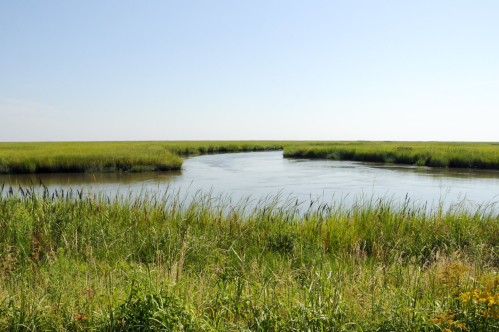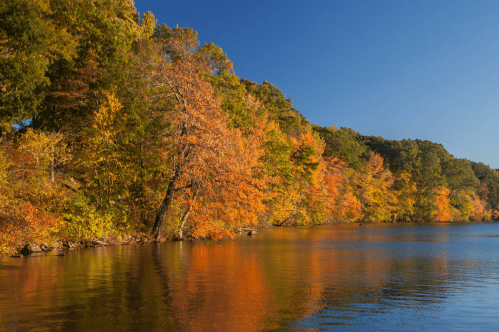From temperamental volcanoes and craggy mountain peaks to glasslike crater lakes and imposing rock formations forged from every natural element known to man, the geologic wonders of the world never cease to amaze. Luckily for us, Montana is undeniably packed with every manner of natural wonders! But while Montana's lush western half gets much of the glory (and crowds), we're big fans of the road less traveled and the unique geology found beyond social media's most infamous hotspots. These seven underrated geologic formations in central and eastern Montana may be hidden gems for many, but they're 100% worth a visit in every season.
1. Terry Badlands - Terry
The stark, rolling prairies of Eastern Montana's Badlands show off a colorful, quiet slice of Big Sky Country that is often overlooked. Pristine, undeveloped, and stretching as far as the eye can see, the banded sandstone bridges, tabletops, and spires of the Terry Badlands create a rugged, otherworldly landscape that is idyllic to explore via the meandering trails. A sunset here is especially magical, but the vibrant character of this 44,000-acre Wilderness Study Area is made even more serene thanks to the lack of crowds.
Eons of wind and water erosion have carved each stunning formation here - both those that tower above ground and the channeled gullies that lie in between. And in spring? A sea of ancient wildflowers unlike any you'll find nearby. Visit the BLM office in Miles City to grab a trail map.
2. Medicine Rocks State Park - Ekalaka
Hiding in Southeast Montana is a museum-like forest of sculpted, windswept stone formations intermixed with lush grassland hills. Every pillar, column, and arch is unique, and, even more fascinating, many of these geologic formations have historic pictographs and petroglyphs on them.
The natural rock sculptures at Medicine Rocks are thought to be over 60 million years old and formed by ancient tides (this was back when Montana had a coastline!). Since then, the area has been used by a number of Native American tribes for sacred and ceremonial purposes, but visitors will also find more modern inscriptions by early pioneers and settlers from the 1800s. Stop by the park Visitor Center to learn about Herbert Dalton, who carved many of the most intricate rock art examples seen at Medicine Rocks today.
3. Pryor Mountains - Pryor
It might seem strange for a mountain range to make its way onto a list of overlooked geologic formations in Montana, but the Pryor Mountains are a truly special piece of the Treasure State - unexpected, even.
Unlike the jagged, glacier-carved Beartooth Mountains farther west, this 5,000-foot high range rises up out of the prairie meadow like an island, uniquely formed by uplifted rock pushing from deep below the earth's surface. As such, the Pryor mountains are a stunning region that is full of rugged canyons, ice caves, and winding creeks, while also housing an incredibly diverse number of animals and ecosystems. You'll find two sub-alpine plateaus to explore here: Big Pryor Mountain and East Pryor Mountain. Both offer trails, gorgeous overlooks, and plenty of hidden surprises to enjoy.
4. Pompey's Pillar - Nibbe
Jutting out of the earth in south-central Montana, Pompey's Pillar has been a landmark for centuries. In fact, it's the only sandstone outcrop of its kind south of the Yellowstone River - although, you might notice that it's decidedly un-pillarlike, and rather more… loaf-like.
In addition to being one of Montana's most unique rock formations and a stellar overlook spot, this grandiose, 130-foot-tall natural feature is also brimming with history. Not only was Pompey's Pillar likely named after Jean Baptiste Charbonneau (a.k.a. baby "Pomp") of the Lewis and Clark Expedition, but it is also the only spot on the Lewis and Clark History Trail to still have tangible evidence of the Corps' travels. Clark's signature can be found etched into the rock and is now protected from further aging.
5. White Cliffs - Fort Benton
If you've ever visited the Upper Missouri Breaks National Monument and looked up from a float down the water or stopped at an overlook, you've likely seen Montana's treasured White Cliffs. But do you know their history?
Meriwether Lewis himself described the sight of these soft white pillar formations as "romantic" and "remarkable" in 1805, and even today the vast scene is nothing if not picturesque. Each perfectly formed pillar is capped by dark, rich loam and stands around 300 feet tall, towering above the winding Missouri River. Ancient waters carved and eroded these stunning monuments, pressing layers of sandstone deposits into the magnificent natural towers we see today. While the Missouri Breaks are a beloved and well-visited slice of Montana, the next time you're here, pause for a few moments to look around at the multitude of hilly formations in the area and admire the scenic wonder that is the Montana White Cliffs.
6. Rock City - Valier
Tucked away in small-town Montana is a sea of skyscrapers - only these high-rise landmarks are made of rock and handcrafted by nature itself. This natural "city" of rocks offers an incredible opportunity to stroll through ancient formations that were formed by the ebbs and flows of the powerful Two Medicine River.
Flat-top, mushroom-shaped hoodoos galore fill the landscape, some nearly three stories in height, along with eerie natural features that pique the curiosity and ignite the imagination. On some, unique rock layers are more clearly visible here than in other badlands areas in Montana, showcasing the intense geologic history that took place for them to be formed. While not designated as an official state scenic or wilderness area at this time, Rock City in Valier is arguably denser with formations than Jerusalem Rocks up north. This is one spot that's definitely worth a visit!
7. Makoshika State Park - Glendive
As Montana's largest state park, Makoshika may not be hidden per se, but for many, it's definitely underrated. In addition to finding epic rock formations, nature trails, and stunning Badlands landscapes to explore (many dating all the way back to the Cretaceous period), you might also unknowingly find yourself walking above the remains of dinosaurs and other prehistoric creatures here.
As part of the Montana Dinosaur Trail, you'll even be able to see the K-T boundary line: the geologic line between where the Cretaceous period ended and the Tertiary (Paleogene) period began. In fact, while Montana's Badlands roll their way into the Dakotas, the rocks here are much older than those nearby, and as such, are still filled with surprises: hidden ponds, fossil remnants (please don't touch!), and even vibrant foliage, since erosion hasn't fully taken its toll yet. Be sure to check out the Visitor Center to see some ancient fossils and interpretive exhibits and to learn more about the area!
How many of these incredible spots in eastern and central Montana can you check off your bucket list? Are there any we should add?
Looking for yet another epic challenge? Get up close and personal with one of the most unique natural wonders in Montana's Bob Marshall Wilderness.
Get the latest updates and news
Thank you for subscribing!
































